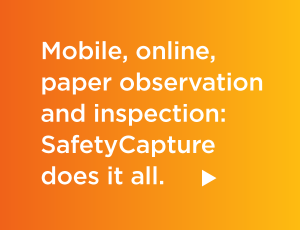 For many organizations, across a broad spectrum of industries, workplace safety is regarded as a necessary cost of doing business—and often a necessary evil that doesn’t garner its fair share of attention and organizational investment.
For many organizations, across a broad spectrum of industries, workplace safety is regarded as a necessary cost of doing business—and often a necessary evil that doesn’t garner its fair share of attention and organizational investment.
Naturally, organizations want to protect the well-being of employees and workers. However, to remain competitive and profitable, they also need to avoid the financial impact of safety regulation non-compliance, increased insurance premiums, increased employee sick days, and productivity loss. For many proactive organizations, there is now growing recognition that an effective, high-performing safety culture must include a focused set of behavior-based safety (BBS) practices to drive a greater reduction of at-risk behaviors. It’s these at-risk behaviors that organizations are identifying as leading contributors to ongoing productivity loss and eroding profitability.
In many cases, the road to a high-functioning BBS program comes with its own set of challenges, many of which result from a failure to clearly define program goals and objectives. That includes anticipating key organizational barriers that can threaten not only successful program adoption, but also the long-term stability and strength of the larger safety culture.
The Data Management Barrier
Safety observations in large facilities, factories, and plants can cover a broad spectrum of highly specialized tasks and processes, each of which may include countless behaviors that can result in workplace injuries or production downtime. Observing these processes can quickly generate thousands of safety observation forms. When organizations don’t proactively define a practical plan for moving that data into their reporting systems, an emerging BBS program can rapidly reach a point of crisis.
“Large volumes of safety observation data become trapped in paper forms that are manually intensive to collect and process—that’s the crux of the problem,” said Brian Hammill, manager of business development at Scantron. “It can often spell disaster for a behavior-based program that’s so reliant on unlocking the value of that data and communicating feedback and insights to multiple levels within the organization.”
With increasing economic pressure on organizations to eliminate resources and reduce safety program budgets, there often simply isn’t enough labor and expertise to transform that raw data into actionable insight needed to make better, timelier safety decisions. Disengagement and apathy then take hold: workers fail to see how their diligent safety observations are leading to increased safety on the front lines, while management sees no demonstrable return on their BBS investment.
 Key Takeaway: Before implementing an effective BBS program with proven results on the front lines (preventing workplace injuries and eliminating at-risk behaviors) and on the bottom line (increased productivity and profitability), organizations must focus on building consensus around a holistic, enterprise-wide BBS strategy with data automation at the core. Toppling the data-management barrier at the outset can dramatically increase the chances that stakeholders will see measurable value earlier in the process. That early success drives further motivation and engagement that can help to make BBS stick over the long term.
Key Takeaway: Before implementing an effective BBS program with proven results on the front lines (preventing workplace injuries and eliminating at-risk behaviors) and on the bottom line (increased productivity and profitability), organizations must focus on building consensus around a holistic, enterprise-wide BBS strategy with data automation at the core. Toppling the data-management barrier at the outset can dramatically increase the chances that stakeholders will see measurable value earlier in the process. That early success drives further motivation and engagement that can help to make BBS stick over the long term.
The Executive Sponsorship Barrier
Research in the safety arena continues to demonstrate the importance of buy-in at every level of the corporate structure, and this is especially true at the most senior levels. Without an executive safety sponsor committed to transforming the organization into a safety leader, it’s challenging to get the cross-functional organizational support needed to capitalize on the data captured during an operational BBS program.
According to a recent study by Aberdeen Group (Integrated Safety Systems: Ensuring Safety and Operational Performance, November 2011), 70 percent of best-in-class companies have a formalized safety strategy with executive accountability to address all risks within their safety systems, while just 46 percent of laggard companies have such a strategy. The performance gap between these categories is stark: best-in-class companies have a fraction of first-time and repeat injury rates while posting substantially higher productivity and profitability results.
 Key Takeaway: Having an enterprise-wide commitment to a BBS program requires executive-level endorsement that helps to champion program objectives and preserve program operating budgets.
Key Takeaway: Having an enterprise-wide commitment to a BBS program requires executive-level endorsement that helps to champion program objectives and preserve program operating budgets.
Safety managers and leaders should first strive to build the business case for an executive-endorsed BBS program that has a high profile across the organization.
The Awareness Barrier
It’s common for safety managers and leaders to drive their BBS programs forward without enterprise-wide commitment, sufficient resources, or the enabling technology needed to build a strong safety culture. Armed with limited resources and few automated tools, they often focus their attention on time and labor-intensive manual data collection, processing, distribution, and reporting. In many cases, they are simply unaware that more efficient, automated tools are available to dramatically reduce the time and resources needed to solve operational problems.
“Data processing delays and bottlenecks ultimately contribute to the perception of unproven return on BBS program investments,” says Darrick Jensen, product manager at Scantron. “And without committed budgets or research time, there is often limited awareness of the automation innovations that can help to transform mountains of paper forms into the actionable safety insights corporate leaders nevertheless expect from under-funded safety programs.”
 Key Takeaway: Lack of awareness can serve to amplify an existing data management problem, cementing the belief across the enterprise that BBS programs deliver poor value. It’s critical for safety program managers and supporting staff to carve out enough time to survey new technology innovations that can play a key role in BBS programs, particularly when it comes to data automation. When implemented early in the lifecycle of a BBS program, automated data-processing tools and services can deliver time-sensitive insights to functional areas across the entire enterprise. When these insights are put into action sooner to correct at-risk and near-miss behaviors, BBS programs stand a much better chance of delivering measurable value.
Key Takeaway: Lack of awareness can serve to amplify an existing data management problem, cementing the belief across the enterprise that BBS programs deliver poor value. It’s critical for safety program managers and supporting staff to carve out enough time to survey new technology innovations that can play a key role in BBS programs, particularly when it comes to data automation. When implemented early in the lifecycle of a BBS program, automated data-processing tools and services can deliver time-sensitive insights to functional areas across the entire enterprise. When these insights are put into action sooner to correct at-risk and near-miss behaviors, BBS programs stand a much better chance of delivering measurable value.
The IT Barrier
When organizations manage to overcome the awareness barrier and become fully aware of technology solutions to automate the movement of safety observation form data into their reporting systems, another barrier often blocks their progress: competing for existing IT resources and budget. It’s no surprise that the primary mandate of IT organizations in many industries is maintaining operating and production capacity; investment in safety program technology is generally a lower priority. IT dollars and resources are hotly contested, which presents a big barrier for safety program managers and leaders who are looking to solve the technology challenges that plague many BBS programs.
“In many cases, the safety organization is further challenged by the IT resource commitment required to support BBS,” adds Jensen. “This includes the software and hardware needed to collect, process, and store safety observation data, then make it available across the enterprise to support key operating decisions. That’s why many BBS program supporters are now endorsing on-demand, outsourced solutions that help to eliminate many of the financial and resource objections.”
Hosted, on-demand solutions can dramatically reduce the IT resource and cost burden associated with installing and maintaining customized safety observation software, while also easing training and adoption. They also allow IT to maintain focus on critical production and operating systems, without having to acquire additional safety systems expertise.
 Key Takeaway: Leading organizations that take full advantage of outsourced, on-demand services are building stronger safety cultures and driving increased support for behavior-based safety strategies. When it comes to BBS and IT investments, the technology conversation must include on-demand technology solutions—they are playing an increasingly strategic role in BBS programs that demonstrate measurable value.
Key Takeaway: Leading organizations that take full advantage of outsourced, on-demand services are building stronger safety cultures and driving increased support for behavior-based safety strategies. When it comes to BBS and IT investments, the technology conversation must include on-demand technology solutions—they are playing an increasingly strategic role in BBS programs that demonstrate measurable value.
When organizations break down the barriers to implementing a successful BBS program, they ultimately create the foundation for building a more holistic safety culture with defined goals and objectives, proven return on investment, and top-to-bottom organizational engagement.


Social
View our latest posts or connect with us below on Social Media.